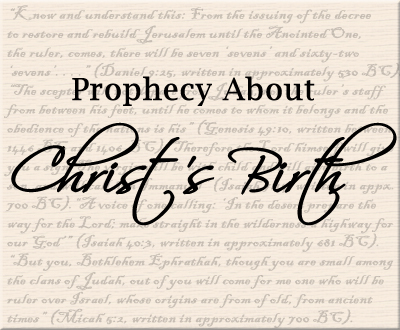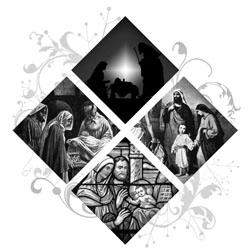Christmas Trivia
Genealogy of Jesus
Note that this section is drawn from our featured Christmas book.
See a side-by-side comparison of the genealogies of Jesus in the Bible.
One of the most obvious “discrepancies” in the gospel accounts of the Nativity is the difference in the genealogies of Jesus as given by Matthew and Luke. Matthew’s list begins with Abraham and descends to Jesus, whereas Luke’s list begins with Jesus and ascends to Adam. This does not present a significant problem until the succession from David begins.
The first problem is that Matthew lists 26 generations between David and Jesus and Luke lists 41, but this incongruity is fairly easy to resolve. According to A Harmony of the Gospels by Robert L. Thomas and Stanley N. Gundry:
“Omission of generations in biblical genealogies is not unique to this case, and Jews are known to have done this freely. The purpose of a genealogy was not to account for every generation but to establish the fact of an undoubted succession, including especially the more important ancestors.”1
The second problem is more difficult to resolve. Between Matthew and Luke’s genealogies, other than Shealtiel and Zerubbabel, every descendant after David is different. Though at first this appears to be an irreconcilable problem in Scripture, further research reveals that it is actually an intriguing fulfillment of prophecy.
In order to understand the genealogies, we must first look back to the Old Testament when God made an unconditional promise to King David:
“‘When your days are over and you rest with your fathers, I will raise up your offspring to succeed you, who will come from your own body, and I will establish his kingdom. He is the one who will build a house for my Name, and I will establish the throne of his kingdom forever. I will be his father, and he will be my son. . . Your house and your kingdom will endure forever before me; your throne will be established forever’” (2 Samuel 7:12-16).
God promised that David’s own offspring would reign forever, and several generations later, his descendant Jeconiah, also called Jehoiakim, sat on his throne as king of Judah. But Jeconiah was an evil man and was cursed by God as a result:
“This is what the LORD says: ‘Record this man as if childless, a man who will not prosper in his lifetime, for none of his offspring will prosper, none will sit on the throne of David or rule anymore in Judah’” (Jeremiah 22:30).
This creates a dilemma. Jeconiah and his descendants had a legal right to the throne of David, but God declared that his offspring would never rule again. How could God’s promise to David and his curse on Jeconiah both be fulfilled? Look to the genealogies of Jesus to understand.
First, Matthew traces Jesus’ descent through Joseph to reveal that he had a “legal” right to David’s throne. But since Joseph was a descendant of Jeconiah, Matthew is careful to show that Jesus was not actually Joseph’s offspring. He calls Joseph “the husband of Mary, of whom was born Jesus, who is called Christ” (Matthew 1:16). The word “whom” in Greek is feminine singular in form and clearly refers back to Mary. Scholars Thomas and Gundry summarize this fact:
“As to human parentage, Jesus was born of Mary alone, though Joseph was his legal father. As Jesus’ legal father, Joseph’s legal claim passed to Jesus. But because Jesus was not actually of Jeconiah’s seed . . . Jesus escaped the curse.”2
Next, Luke undertakes the task of tracing Jesus’ actual physical descent. This is important in light of God’s promise to David that Messiah would come from his own body. But the fact that Jesus had no human father creates a unique challenge for Luke. His solution is to record Mary’s genealogy; however, he is careful to conform to custom by not mentioning her name. In effect, Luke removes Joseph from the genealogy by saying of Jesus, “He was the son, so it was thought, of Joseph” (Luke 1:23). Thomas and Gundry explain:
“By this device Joseph’s name is shown to be not properly part of the genealogy. Jesus was only thought to be his son. This would make Jesus the son (i.e., grandson or descendant) of Eli, Mary’s progenitor, and is consistent with Luke’s account of Jesus’ conception, which makes clear that Joseph was not his physical father.”3
In summary, the gospels record two different genealogies for Jesus. Matthew traces Joseph’s line and confirms Jesus’ right to David’s throne through his legal father. Luke traces Mary’s line to reveal that, though Jesus was a physical descendant of David, he avoided the curse placed on Jeconiah. The common names found in the genealogies, Shealtiel and Zerubbabel, do not represent the same people.
One other point in regard to Jesus’ ancestry is worth mentioning. Luke 1:5 records that Elizabeth, Mary’s relative, was a descendant of Aaron. This implies that Mary may also have come from the line of Aaron. In Exodus 29:9, God proclaims that the priesthood of Israel belongs to Aaron and his sons by “lasting ordinance.” This is intriguing in light of Jesus’ ministry as a priest. Hebrews 2:17 says, “For this reason he had to be made like his brothers in every way, in order that he might become a merciful and faithful high priest in service to God, and that he might make atonement for the sins of the people.”
1 Thomas, Robert T. and Gundry, Stanley N. A Harmony of the Gospels with Explanations and Essays. Harper Collins, 1978, p. 315.
2 Thomas, Robert T. and Gundry, Stanley N., p. 318.
3 Thomas, Robert T. and Gundry, Stanley N., p. 317.
Back to Trivia Page.






